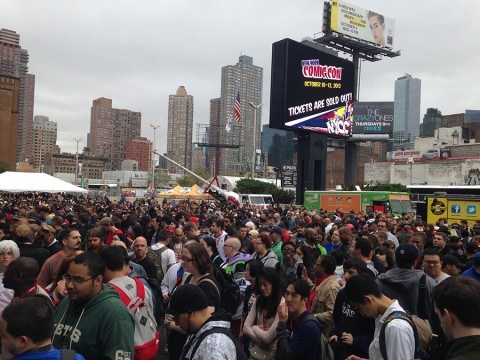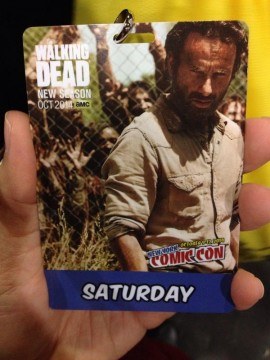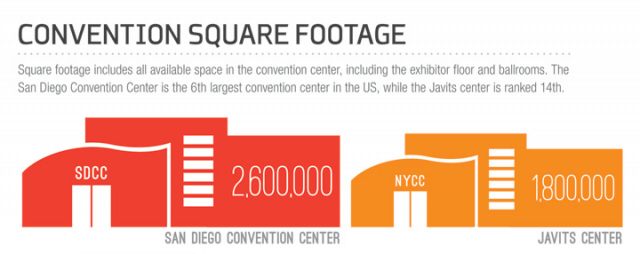 A lot of things happened at New York Comic Con last weekend — fans were treated to an all-new trailer for Avengers 2: Age of Ultron, the Tomorrowland teaser trailer debuted, some lucky fans got to see Big Hero 6 ahead of its November release, The Legend of Korra got a farewell panel ahead of its final episodes. But the biggest news coming out of the convention seemed to be an interesting statistic: New York Comic Con had a “unique attendee” size of 151,000.
A lot of things happened at New York Comic Con last weekend — fans were treated to an all-new trailer for Avengers 2: Age of Ultron, the Tomorrowland teaser trailer debuted, some lucky fans got to see Big Hero 6 ahead of its November release, The Legend of Korra got a farewell panel ahead of its final episodes. But the biggest news coming out of the convention seemed to be an interesting statistic: New York Comic Con had a “unique attendee” size of 151,000.
This is interesting primarily because San Diego Comic-Con, which has long held the title of the biggest North American pop culture convention (and you can view our infographic comparing it to other popular conventions in terms of attendance size, square footage, price, and more, here), has an attendee size of around 133,000.
So did New York Comic Con beat out San Diego to take over the title of the largest pop culture and comics convention this side of the globe? Well, not really.
We spoke to Lance Fensterman, the Senior Global Vice President of ReedPOP, the company behind NYCC, about the size of attendance. As it turns out, the convention did sell 151,000 tickets — “and the actual number is a little higher” but rounded down for the sake of simplicity — but that doesn’t mean that 151,000 people attended.
So how does that work? “By unique tickets sold we mean that one person counts as one person,” Fensterman said. “So if you buy a four day pass you count as one ticket sold. If you buy a one day pass you count as one person.”
Sounds simple enough. But much like San Diego Comic-Con, New York offers a wide array of ticket options, which includes everything from a four day ticket as a single-click purchase, to a more a la carte selection, where attendees can pick and choose exactly which days they want to attend.

So under New York Comic Con’s counting system, how would someone who purchased two single tickets be counted? As two separate unique tickets, and thus, as two separate people.
“If someone bought a single day Friday and single day Sunday that would be 2 tickets sold,” Fensterman said.
This means, essentially, that New York Comic Con sold 151,000 tickets all combined, but the number of actual, unique attendees is less than that. After all, if even 1,000 attendees purchased two single day tickets, they would be counted as 2,000 people, even though this isn’t Orphan Black and attendees aren’t being cloned left and right.
If even 10,000 people purchased two single day badges (and that number is likely significantly higher)? The system is counting them at 20,000 people.
And what of people who bought four single day tickets, after the four-day combined tickets sold out? Under this system, each of those people would each be counted as four “unique” attendees — meaning that if even 6,000 people (which is less than 4% of the number of attendees New York Comic Con is counting under this system) purchased all four single days, they would be counted as 24,000 people instead, which is 18,000 more than really purchased tickets. That already would put New York Comic Con’s attendance size back below San Diego’s.
That’s a lot of room for guesswork and error in attendance size.
New York has a very good reason for counting attendees this way, though, and it’s not to inflate or misreport their numbers. Instead, it’s simply the best way to count attendance size at the convention under the way it’s currently run.
Unlike at San Diego, where attendees sign up for a unique Member ID that ties their badge to them, and then requires an ID to pick-up on site, New York Comic Con mails out badges to attendees. The type of badge purchased is printed on the physical badge — Friday, 4-Day, etc. — but without attendee names. This effectively means that someone could buy a Friday and Saturday badge, and give one to their great aunt, and New York Comic Con would never know, or care. Once you’ve bought your badge, it’s yours to do with as you please.

“We have no way to determine who is using those tickets [nor] does it really make any material difference,” Fensterman said. “We theoretically could parse that data in any number of ways depending on how much time and effort and resource we want to put into it. But ultimately the unique ticket sold metric seems to balance giving the most accurate representation of the size of the audience without us going nuts parsing data that really does not add that much value to the customers.”
San Diego, on the other hand, counts attendee size by unique people rather than the number of badges sold, making it very difficult to compare which convention is larger when they don’t use the same metrics.
However, if we had to wager a guess, we’d still assume that San Diego is the larger convention, for a few important reasons:
San Diego has more square footage
Just look at the math. Both conventions sold out this year and filled to capacity, but San Diego simply has more room to play with. The San Diego Convention Center clocks in at 2,600,000 square feet and is ranked as the 6th largest convention center in the US, while the Javits Center holds at 1,8000,000 square feet total, and is ranked as the 14th largest convention center in the US.
To add to that, New York Comic Con doesn’t utilize all of the space in the Javits Center. The entire fourth floor of office space isn’t used by the convention (CORRECTION: Part of the fourth floor was used by VIP attendees), as well as a few other spaces throughout. In San Diego, Comic-Con International also pulls in neighboring hotels like the Hilton Bayfront for programming. More space = more bodies.

Offsite Events
New York Comic Con kicked of Super Week this year, which aims to kickstart the offsite scene for New York Comic Con attendees. It’s hopefully going to be the start of a new tradition for the convention and give attendees more choices both during and after convention hours.
However, it’s not yet at the level of San Diego, which turns all of downtown San Diego into a “Comic-Con campus” of everything from panels to gaming to activities that, most importantly, manages to draw in out-of-towners who don’t have a badge.
New York Comic Con did a lot of things right this year — we’re currently drooling over how well their wristband and stage clearing system seemed to work — but if we’re going to talk about who has the title of the biggest pop culture convention? Let’s at least get our facts straight.






